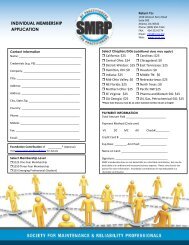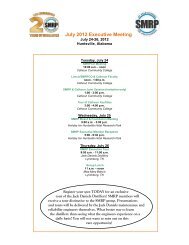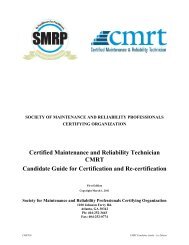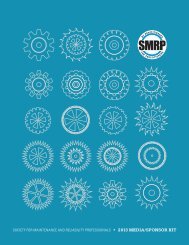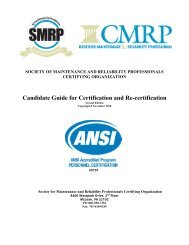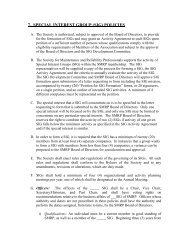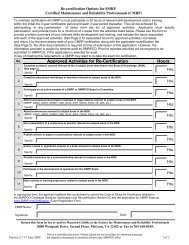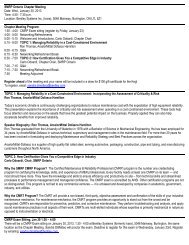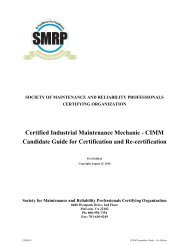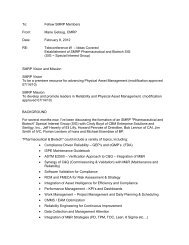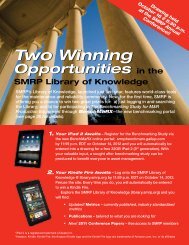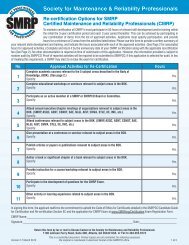conference brochure - Society for Maintenance & Reliability ...
conference brochure - Society for Maintenance & Reliability ...
conference brochure - Society for Maintenance & Reliability ...
- No tags were found...
You also want an ePaper? Increase the reach of your titles
YUMPU automatically turns print PDFs into web optimized ePapers that Google loves.
WorkshopsWorkshop #10<strong>Maintenance</strong> Management 101/201Bruce Hawkins, Management Resources Group, Inc.Monday, October 15, 20128:00 a.m. – 5:00 p.m.Much has been written about advanced reliability and strategiesand tools such as RCM, TPM, Predictive Technologies, and EAMSystems. Many books and articles illustrating their successfulimplementation appear every day. Indeed, they are some of themost valuable tools an organization can use to advance downthe road to a proactive reliability culture.For these tools to be of maximum value, the organization mustbe ready to use them effectively. Like a farmer preparing his/her fields by tilling and fertilizing, the organization must bearmed with some fundamental philosophies and values so theseadvanced concepts can take root. Without these fundamentals,an organization has the potential to invest significant resourcesinto one or more of these tools and receive little sustainablebenefit.These fundamental philosophies can only come from themaintenance & reliability leader. This individual must set the rightexpectations and rein<strong>for</strong>ce these through the correct behaviors<strong>for</strong> the organization to develop the necessary discipline toeffectively use the tools. Un<strong>for</strong>tunately, there is no “primer” that amaintenance manager can turn to where these philosophies areexplained.Most effective managers learn these fundamentals througha good mentor or through experience – the school of “hardknocks.” So what if you don’t have a mentor and can’t af<strong>for</strong>d tomake the mistakes necessary to gain experience? Not to worry,this workshop will explore several of the most important lessonsthat a maintenance & reliability leader must learn to create thefoundation <strong>for</strong> a proactive maintenance culture.Workshop #11Leading the Per<strong>for</strong>mance CultureTrans<strong>for</strong>mationBrad Peterson & Ian Hedding, SAMIare often unsustainable because the culture did not embraceand adopt the new methods, tools, and processes by exhibitingthe required behaviors.This workshop will go through a detailed summary of thePer<strong>for</strong>mance Culture, as well as the philosophy and methodsthat are used in creating this type of organization. Significanttime will be spent discussing the 4 Ps of the Per<strong>for</strong>manceCulture: Predictability, per<strong>for</strong>mance, people, and purpose.In addition to these domains that drive sustainable businessper<strong>for</strong>mance improvements, the workshop presenters willdive deeper into the supporting elements of each of the 4Ps, to provide a detailed understanding of the core drivers ofbehavioral and cultural change.We will review specific case studies, as well as our article“Creating the Per<strong>for</strong>mance Culture,” which outlines SAMI’sthought leadership behind the quantification of cultural change.Graphical models will be used to support the discussion ofcultural trans<strong>for</strong>mation, with a be<strong>for</strong>e-and-after look into areactive culture turned Per<strong>for</strong>mance Culture.Workshop #12<strong>Maintenance</strong> Planning & SchedulingDoc Palmer, Richard Palmer and AssociatesMonday, October 15, 20128:00 a.m. – 5:00 p.m.<strong>Maintenance</strong> planning and scheduling should dramaticallyimprove the productivity of maintenance. For example, agroup of 30 maintenance technicians should be per<strong>for</strong>ming thework of 47 persons when aided by a single planner. Yet mostmaintenance organizations do not have a planning functionand most that do are frustrated. The author of McGraw-Hill’s<strong>Maintenance</strong> Planning and Scheduling Handbook, Doc Palmer,reviews the fundamentals and then leads class exercises toillustrate the principles and techniques to achieve success.This workshop not only covers the theory and vision, but alsothe nuts and bolts of how planning and scheduling work. Thisworkshop allows class participants to take specific practiceshome to their own organizations. Participants should be able toimplement a new planning organization or dramatically improvean existing planning organization.Monday, October 15, 20128:00 a.m. – 5:00 p.m.Most organizations are good at developing detailed businessprocesses, building task lists, and creating requirements <strong>for</strong>measuring per<strong>for</strong>mance in one way or another. We oftensee companies track financial and functional per<strong>for</strong>mance,but seldom find companies who define, quantify, and trackbehavioral and/or cultural per<strong>for</strong>mance. When a companydoesn’t execute the steps to define the specific behaviors thatwill drive cultural trans<strong>for</strong>mation, any improvement initiativethe company undertakes is up against systemic culturalresistance. In many cases, these initiatives truly fail but aredeclared successes. This isn’t a new concept, but rather anacknowledged fact: Benefits associated improvement initiatives10



